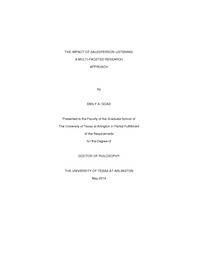
ATTENTION: The works hosted here are being migrated to a new repository that will consolidate resources, improve discoverability, and better show UTA's research impact on the global community. We will update authors as the migration progresses. Please see MavMatrix for more information.
Show simple item record
| dc.contributor.author | Goad, Emily A. | en_US |
| dc.date.accessioned | 2014-07-14T20:29:01Z | |
| dc.date.available | 2014-07-14T20:29:01Z | |
| dc.date.issued | 2014-07-14 | |
| dc.date.submitted | January 2014 | en_US |
| dc.identifier.other | DISS-12707 | en_US |
| dc.identifier.uri | http://hdl.handle.net/10106/24469 | |
| dc.description.abstract | Relationships are based on communication between parties; an important aspect of communication that is necessary for building long-term relationships is listening (Ingram et al. 1992). In sales, researchers have posited that salespeople's relationships with their customers are strengthened when salespeople consistently have effective listening skills (Ramsey and Sohi 1997; Marshall et al. 2003). Given the importance of listening in relationship building and the sales context, this dissertation examines salesperson listening from varying research approaches in three essays. First, a meta-analysis was conducted to synthesize existing empirical research on listening to empirically assess the research stream of salesperson listening. This meta-analysis expands sales researchers' understanding of not only the listening process, but the framework that surrounds salesperson listening, thus advancing listening theory. Next, relying on relationship marketing theory (Morgan and Hunt 1994; Palmatier et al. 2006), and the dual process theory of supportive message outcomes (Bodie 2009), the second essay proposes and tests a cascading model of listening that incorporates previous researches' suggestions that listening is a process, instead of a higher order construct. Results show that salesperson listening is a process in which the behavioral component (responding), has the greatest impact on outcomes like: customer satisfaction and customer loyalty to the firm. Furthermore, it is shown that a lack of salesperson diligence actually diminishes the positive effect of the responding aspect of listening on customer satisfaction. Lastly, the third essay updates and extends Drollinger, Comer, and Warrington (2006)'s Active Empathetic Listening (AEL) scale showing that the responding component of listening is not only comprised of verbal behaviors, but also nonverbal behaviors and the use of technology. New items reflecting nonverbal behaviors and technology are incorporated into the AEL scale. Furthermore, a model is tested with the updated responding dimension of salesperson listening and the temporal aspects of listening which occur pre- and post- interaction. Previous research has suggested that there are temporal dimensions of listening, but this is the first research to empirically test these dimensions and the resulting impact on salesperson performance. Results indicate that the responding dimension of listening is preceded by pre-interaction salesperson behaviors, and followed by post-interaction salesperson behaviors which, in turn, have a positive impact on salesperson performance. | en_US |
| dc.description.sponsorship | Jaramillo, Fernando | en_US |
| dc.language.iso | en | en_US |
| dc.publisher | Marketing | en_US |
| dc.title | The Impact Of Salesperson Listening: A Multi-faceted Research Approach | en_US |
| dc.type | Ph.D. | en_US |
| dc.contributor.committeeChair | Jaramillo, Fernando | en_US |
| dc.degree.department | Marketing | en_US |
| dc.degree.discipline | Marketing | en_US |
| dc.degree.grantor | University of Texas at Arlington | en_US |
| dc.degree.level | doctoral | en_US |
| dc.degree.name | Ph.D. | en_US |
Files in this item
- Name:
- Goad_uta_2502D_12707.pdf
- Size:
- 867.1Kb
- Format:
- PDF
This item appears in the following Collection(s)
Show simple item record


